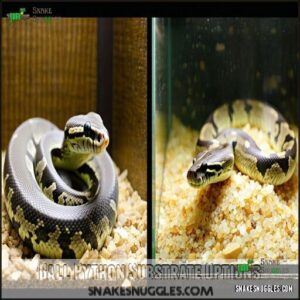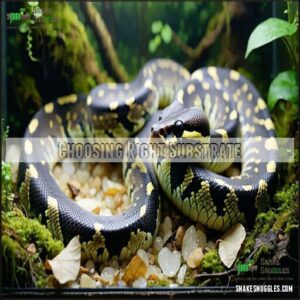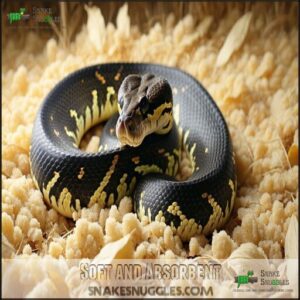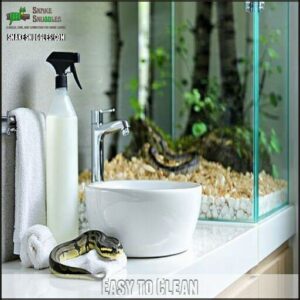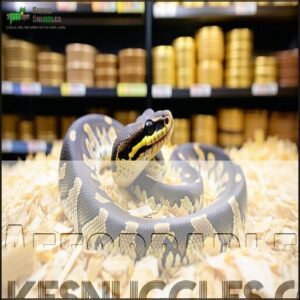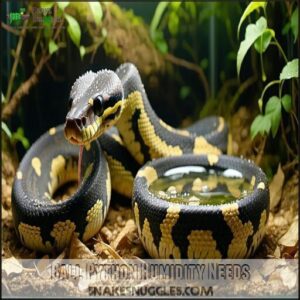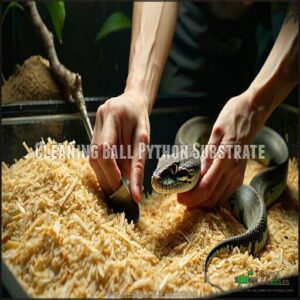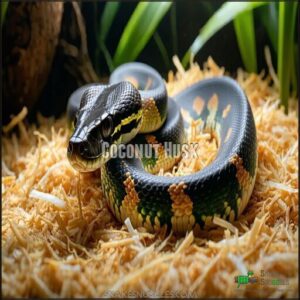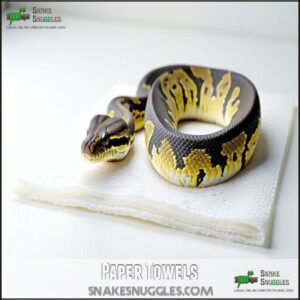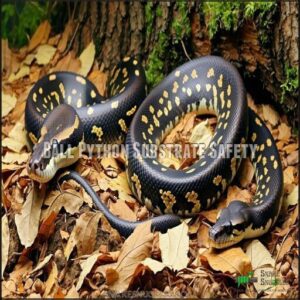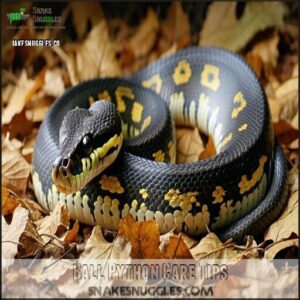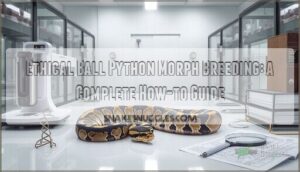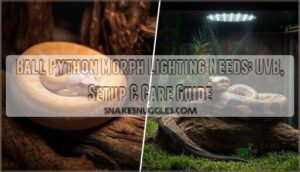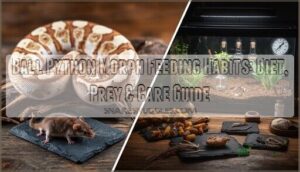This site is supported by our readers. We may earn a commission, at no cost to you, if you purchase through links.

However, it’s not perfect. Aspen molds quickly when wet and doesn’t maintain humidity well, which can be problematic since ball pythons need 50-60% humidity.
It’s also messy, with pieces often escaping the enclosure (like finding hay in your carpet for days!).
While aspen works well in dry environments, you’ll need to mist more frequently or consider alternatives like cypress mulch for humidity-challenged setups.
The right substrate choice often comes down to your specific enclosure conditions and maintenance preferences.
Table Of Contents
- Key Takeaways
- Ball Python Substrate Options
- Choosing Right Substrate
- Top 5 Ball Python Beddings
- Aspen Bedding Pros
- Aspen Bedding Cons
- Ball Python Humidity Needs
- Cleaning Ball Python Substrate
- Alternatives to Aspen Bedding
- Ball Python Substrate Safety
- Ball Python Care Tips
- Frequently Asked Questions (FAQs)
- Conclusion
Key Takeaways
- Aspen bedding offers affordability, excellent absorbency, and supports natural burrowing behavior, but you’ll need to weigh these benefits against its poor humidity retention for your specific setup.
- You’ll struggle maintaining the 50-60% humidity ball pythons need with aspen bedding, as it dries quickly and can lead to shedding difficulties and respiratory problems if not managed properly.
- When using aspen, you’ll face increased maintenance requirements including more frequent misting, vigilant monitoring for mold growth, and regular substrate changes every 4-6 weeks.
- You should consider alternatives like cypress mulch or coconut fiber if humidity control is challenging in your environment, as these substrates offer better moisture retention while still providing comfort for your snake.
[/Bpros][Bcons][/Bcons][/Bpros_cons]
Ball Python Substrate Options
When choosing a substrate for your ball python, it’s important to weigh options that meet its needs for humidity, safety, and comfort.
From aspen bedding to coconut fiber, each choice has pros and cons that can impact your snake’s health and happiness.
Aspen Bedding
Aspen bedding is one of the go-to options for ball pythons, offering affordability and convenience.
It’s soft, absorbent, and perfect for burrowing.
However, it’s not without drawbacks:
- Aspen Dust may trigger respiratory issues.
- Mold Growth occurs when wet.
- Ingestion Risks can arise during feeding.
- Minimal moisture retention impacts humidity.
- A top pick for a Cost Analysis if managed responsibly.
For ideal snake health, consider humidity regulation importance when selecting substrates.
Cypress Mulch
Cypress mulch is another popular ball python bedding, offering excellent humidity retention and a natural appearance.
Its antimicrobial properties help reduce fungi, but watch for mulch acidity and splinter risks, which could harm your snake.
Compared to aspen snake bedding, it’s pricier but works wonders in maintaining a humid environment—perfect for mimicking your pet’s tropical roots.
Coconut Fiber
Coconut fiber is a popular choice in snake bedding options, offering excellent humidity retention for ball pythons.
However, it’s not perfect—it’s prone to mold growth, has higher dust content, and cleaning difficulty can be a hassle.
While it mimics their natural habitat, there’s a slight fiber impaction risk if ingested.
Consider it carefully in your snake substrate guide.
Choosing Right Substrate
Picking the right substrate for your ball python isn’t just about choice—it’s about balance.
You’ll need something that keeps moisture in check, is easy to clean, and keeps your snake happy and healthy.
Absorbency
Choosing ball python bedding isn’t just about looks—it needs to handle moisture retention well.
Aspen snake bedding absorbs spills and odors effectively but struggles with maintaining proper humidity.
While its absorbency aids odor control and reduces bacterial growth, frequent cleaning becomes necessary, especially at shallow substrate depths.
This is one of aspen bedding’s pros and cons for your ball python.
Dustiness
Dust in aspen snake bedding isn’t just annoying—it can cause respiratory issues for your ball python.
While some brands advertise dust reduction, smaller particle size can still stir up trouble.
Regular cleaning helps, but frequent dust exposure may leave you exploring substrate alternatives.
Considering aspen bedding pros and cons, dustiness is a key factor that warrants careful thought for your pet’s health.
Ease of Cleaning
Cleaning aspen bedding for your ball python is straightforward, making it a favorite for busy owners.
Its lightweight nature allows for easy spot cleaning and fast waste removal.
Here’s why aspen snake bedding works:
- Spot cleaning takes seconds.
- Minimal substrate replacement is needed.
- Regular cleaning frequency keeps odors away.
- Sanitization methods are simple.
Convenience meets efficiency—one of aspen bedding’s biggest pros!
Top 5 Ball Python Beddings
Finding the right bedding for your ball python can feel overwhelming with so many options available.
Let’s explore five popular choices that balance comfort, safety, and practicality for your snake.
1. Zilla Brown Reptile Terrarium Liner

The Zilla Brown Reptile Terrarium Liner is a mess-free, low-maintenance bedding option that’s perfect for beginners.
It’s reusable, easy to rinse with water, and fits snugly thanks to its customizable cut-to-size design.
Made from absorbent, non-abrasive material, it keeps your ball python safe and comfortable.
Plus, an enzyme treatment helps reduce odors, keeping your snake’s habitat fresh longer.
While it lacks natural aesthetics and humidity retention, it’s a safe option, especially for those prioritizing cleanliness and convenience over a natural look.
Best For: Beginners or reptile owners seeking a low-maintenance and safe bedding option for their terrarium.
- Easy to clean and reusable with a simple rinse.
- Customizable cut-to-size design ensures a snug fit.
- Treated with an enzyme to reduce odors for a fresher habitat.
- Lacks natural aesthetics for more realistic terrarium environments.
- Does not retain humidity well compared to natural substrates.
- Limited to brown or green color options, potentially clashing with décor.
2. Kaytee Aspen Small Animal Bedding
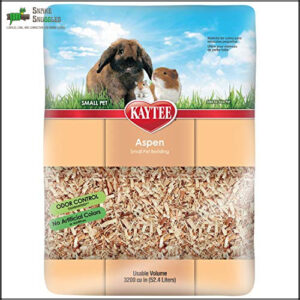
Kaytee Aspen Small Animal Bedding is a solid choice for ball python owners looking for simplicity and affordability.
Made from natural aspen wood, it’s 99.9% dust-free, biodegradable, and free from harmful chemicals, making it a safe bet for your snake.
It absorbs moisture well and helps control odors but struggles with humidity retention, which ball pythons need.
If you’re using it, keep an eye on enclosure humidity and mold, as it’s crucial for maintaining a healthy environment, and it’s easy to clean and works in various setups, from tanks to terrariums, making it a solid choice.
Best For: Ball python owners seeking a natural, cost-effective bedding that’s safe and easy to clean.
- 99.9% dust-free and free from harmful chemicals.
- Absorbent and effective at controlling odors.
- Biodegradable and eco-friendly.
- Poor humidity retention, essential for ball pythons.
- Susceptible to mold in damp conditions.
- Potential sharp edges may pose risks to scales.
3. Fluker’s Coconut Fiber Reptile Bedding
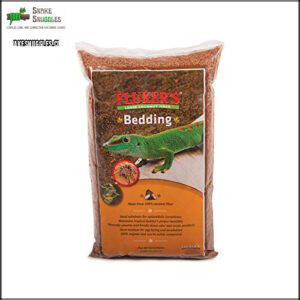
Perfect for maintaining a tropical vibe, Fluker’s Coconut Fiber Reptile Bedding checks all the boxes for your ball python.
Made from natural coconut husks, it absorbs moisture like a champ, keeping humidity levels just right.
It’s a natural fit if your snake thrives in a humid setup. Plus, cleaning is easy since it decays slowly.
Whether you’re housing a snake or a rainforest critter, this bedding works wonders. Bonus: it’s compostable, so it’s good for your pet and the planet!
Best For: Tropical reptile and amphibian owners needing a natural, humidity-friendly bedding option.
- Maintains optimal humidity levels for tropical habitats.
- Made from 100% natural, compostable coconut husks.
- Suitable for a wide range of reptiles and amphibians.
- No details provided on packaging size or setup instructions.
- Lacks specific stats on moisture absorption.
- Limited information on potential allergens for pets or owners.
4. Zoo Med Forest Floor Bedding
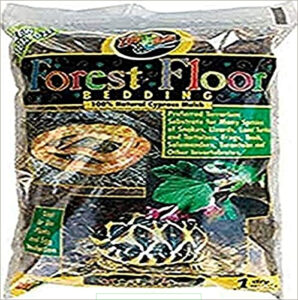
Zoo Med Forest Floor Bedding is made from 100% natural cypress mulch, giving your ball python a cozy, earthy environment.
It’s perfect for maintaining humidity, which is essential for their shedding and health.
The bedding’s natural look mimics a forest floor, making the terrarium feel more like home, and it’s easy to clean and works well for burrowing behavior.
However, you’ll want to watch for moisture buildup to prevent mold, to keep your snake happy and healthy.
Best For: Ball python owners who need a natural, moisture-retaining substrate to support burrowing and humidity control.
- Retains moisture to maintain humidity for proper shedding.
- Provides a naturalistic "forest floor" look.
- Supports burrowing and natural behaviors.
- Needs regular monitoring to avoid mold.
- May not work well in very arid setups.
- Can require more frequent replacement to stay clean.
5. RediChip Reptile Coconut Chip Bedding
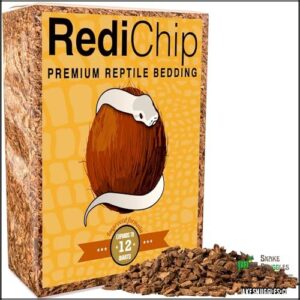
RediChip Reptile Coconut Chip Bedding is a solid choice if you want a clean, eco-friendly substrate for your ball python.
Made from 100% organic coconut chips, it’s dust-free and works for both arid and tropical setups.
You can use it as-is or add water to boost humidity, perfect for maintaining your python’s environment, it’s ready right out of the bag, simple to use, and safe for reptiles.
Plus, it’s versatile enough for bioactive enclosures or mixing with other substrates!
Best For: Reptile owners looking for a clean, eco-friendly substrate that supports both arid and tropical environments.
- Dust-free and made with 100% organic coconut chips.
- Ready to use out of the bag with optional water addition.
- Versatile for bioactive setups or mixing with other substrates.
- Requires moisture adjustment for tropical species.
- Medium-sized chips may not be ideal for very small reptiles.
- Slightly more expensive than other substrate options.
Aspen Bedding Pros
Aspen bedding has plenty of perks, from its soft texture to its excellent absorbency. It’s also affordable and easy to clean, making it a popular choice for snake owners.
Soft and Absorbent
How does aspen snake bedding support your ball python’s needs? It’s soft, making it gentle on their sensitive scales, and its absorbency helps keep the enclosure dry. Plus, it encourages natural burrowing behavior.
Reputable brands like Zoo Med offer quality aspen bedding.
- Comfort prioritization for injury prevention.
- Absorbency comparison shows it’s reliable.
- A great match for snake sensitivity.
- Keeps burrows intact for curious snakes.
- Lightweight, aiding easy setup.
Easy to Clean
With ball python aspen bedding, cleaning is a breeze.
Spot cleaning is quick since waste visibility is excellent against its light color. A full replacement isn’t often needed if you maintain a regular cleaning frequency.
Its ease of cleaning and simple sanitization methods make it a favorite for beginners.
Proper ventilation also helps reduce odors.
Aspen snake bedding truly simplifies your snake’s housekeeping and provides excellent waste visibility.
Affordable
When talking affordability, aspen bedding shines. It’s one of the best budget substrates, fitting even tight wallets.
Here’s why:
- Costs less than many “premium” options.
- Easily available in pet stores and online.
- Reusable for spot-cleaning addicts.
- Buying in bulk saves even more.
- Offers great value compared to cheap alternatives.
To prepare it properly, remember to freeze aspen bedding before use. Ball python aspen bedding pros definitely include your pocket’s happiness! Aspen bedding is a great choice because it provides great value.
Aspen Bedding Cons
Aspen bedding might seem like a great choice, but it has a few downsides you can’t ignore.
It doesn’t hold moisture well, can develop mold if it gets wet, and poses some health risks for your ball python.
Poor Humidity Control
Humidity can be tricky with aspen bedding.
It doesn’t hold moisture well, leading to shedding difficulties and sometimes respiratory problems for your ball python.
This shortcoming makes maintaining proper hydration a challenge, especially in drier environments.
If humidity’s a struggle, consider alternatives like coconut fiber or cypress mulch, which are better at moisture retention and keeping your python healthy.
Molds Easily
When moisture sneaks in, bedding like aspen can quickly sprout mold, making it one of the key aspen bedding cons.
Mold growth but also impacts your ball python’s health if unnoticed, and it smells bad.
Proper humidity management and regular cleaning frequency help prevent issues, considering alternative beddings with better moisture control could save you hassle later, by providing a way to avoid the issues associated with mold growth.
Health Risks
Aspen bedding cons include several health risks for ball pythons that you shouldn’t overlook.
These issues can arise from common problems like:
- Respiratory Issues caused by dust or mold exposure.
- Scale Irritation due to sharp or coarse shavings.
- Ingestion Hazards leading to blockages in the digestive tract.
- Toxicity Concerns if left damp, promoting bacterial growth.
Ball Python Humidity Needs
Keeping your ball python’s habitat at the right humidity level is essential for its health and comfort, especially when it’s shedding.
Since aspen bedding doesn’t hold moisture well, you’ll need to find creative ways to maintain proper humidity.
Ideal Humidity Levels
Keeping humidity steady, around 60%-80%, guarantees your ball python thrives. Proper levels are essential for shedding, hydration, and preventing respiratory infections.
Aspen’s pros include dryness, but it falters here, needing close monitoring. Use a hygrometer to track levels and create a humidity gradient.
Many pet owners buy a reliable digital hygrometer for their ball python’s enclosure.
| Factor | Ideal Range | Risk | Solution |
|---|---|---|---|
| Shedding Humidity | 60%-80% | Stuck sheds | Mist enclosure gently |
| Hydration Importance | Balanced | Dehydration | Water bowl placement |
| Monitoring Methods | Consistent | Over/under misting | Use a digital hygrometer |
| Humidity Gradient | 60%-80% | Stress, poor regulation | Adjust substrate depth |
Substrate Moisture Retention
Your snake’s habitat thrives on the right balance of moisture. Some substrates excel at moisture retention, keeping humidity levels steady.
Aspen bedding, however, struggles here—it’s too dry, often requiring extra misting. Without proper moisture, mold growth and respiratory issues can arise.
Consider using a humidity retaining substrate to avoid these issues. A good option allows:
- Water retention for steady humidity
- Mold prevention safeguards
- Sufficient substrate depth
- Supports burrowing needs
- Natural humidity stability
Humidity Control Tips
To maintain proper humidity, mist the enclosure daily or as needed, depending on the misting frequency and your environment.
Place water bowls near heat sources to increase evaporation. Add humid hides filled with damp moss for moisture retention.
Monitor levels using a reliable python hygrometer.
Guarantee proper airflow with good enclosure ventilation to prevent mold in aspen bedding, ensuring a healthy environment.
Cleaning Ball Python Substrate
Keeping your ball python’s substrate clean is essential for its health and comfort, so don’t put it off for too long.
Regular spot cleaning and full substrate changes help prevent odors, mold, and bacteria from building up, keeping your snake’s habitat fresh and safe.
Removing Waste
Solid waste removal from aspen bedding is a quick and essential part of keeping things sanitary. It helps with odor control and prevents bacteria buildup.
Use spot cleaning daily to maintain hygiene and a fresh enclosure.
- Scoop solid waste promptly to avoid odor.
- Replace soiled sections if necessary.
- Verify all waste is fully removed.
- Combine waste disposal with regular checks.
Spot Cleaning
Spot cleaning aspen bedding isn’t tricky if you’ve got the right tools and a keen eye for waste.
Frequently, grab tongs or gloves to scoop solid waste and control odors. Look for soggy spots to maintain hygiene without a full substrate change. It’s like housekeeping for your snake—quick, effective, and necessary for a happy, healthy habitat.
| Step | Tool | Purpose |
|---|---|---|
| Identify waste | Tongs/Gloves | Solid waste removal |
| Remove wet spots | Paper towels | Odor control |
| Check daily | Visual check | Hygiene practices |
Full Substrate Change
Regular maintenance calls for a full substrate change to keep your ball python’s environment healthy.
You’ll need to completely replace aspen bedding every 4-6 weeks, depending on enclosure size and snake activity.
- Frequency depends on humidity levels—higher humidity requires more frequent changes
- Deep cleaning should coincide with substrate disposal to prevent mite infestations
- Reused substrate can harbor bacteria despite appearing clean
- Cost analysis shows regular changes are cheaper than vet bills from poor husbandry
Regular maintenance, including deep cleaning, is crucial for preventing health issues in your ball python.
Alternatives to Aspen Bedding
If you’re ready to move beyond aspen bedding for your ball python, you’ll find several excellent alternatives that might better suit your snake’s needs.
Coconut husk and paper towels both offer different advantages, with coconut providing superior humidity control while paper products give you the ultimate convenience for cleaning, which includes ultimate convenience.
Coconut Husk
Now that you’ve mastered cleaning techniques, coconut husk (also called coir) offers an excellent aspen alternative for your ball python.
It boasts superior humidity retention, creating that tropical environment your snake craves.
The natural look enhances your enclosure’s aesthetic while supporting natural burrowing behavior.
Though pricier than aspen, its absorbency and resistance to mold often justify the cost.
Remember to monitor for impaction risks, as some snakes might accidentally ingest small pieces during feeding.
Paper Towels
Simplicity offers unmatched convenience when you’re considering paper towels as a ball python substrate.
They’re incredibly cost-effective, allow for easy waste monitoring, and can be quickly replaced when soiled.
While they lack enrichment value compared to naturalistic options, paper towels serve as an excellent temporary substrate during quarantine periods or after cleaning.
Be aware, though, that bacterial growth can occur if you don’t replace them frequently enough, which highlights the importance of frequent replacement for easy waste monitoring.
Ball Python Substrate Safety
You’ll need to be vigilant about your ball python’s substrate safety, as some materials like cedar shavings can cause serious respiratory issues or even prove toxic to your scaly friend.
When choosing bedding for your pet snake, you should prioritize non-toxic options such as cypress mulch, coconut fiber, or paper products that provide the right balance of safety and comfort.
Toxic Substrates
For your ball python’s safety, avoid these dangerously toxic substrates that can cause severe health issues:
- Cedar shavings and redwood – contain harmful aromatic oils causing respiratory issues and liver damage
- Reptile carpet – releases over 40 noxious chemicals affecting the central nervous system
- Sand – causes impaction if ingested and retains zero humidity
- Chemically treated substrates – contain pesticides and other toxins harmful to reptiles
Safe Substrate Options
While avoiding toxic materials is essential, let’s explore what’s actually safe for your ball python.
Safe substrate options include coconut fiber, cypress mulch, and paper products that minimize impaction risks.
When selecting bedding, consider particle size and abrasiveness concerns to prevent scale damage.
Chemical-free options like reptile carpet provide non-toxic alternatives to aspen bedding, though each has its pros and cons.
Always choose substrates with your snake’s health as the priority, and remember to prioritize safe options.
Ball Python Care Tips
You’ll boost your ball python’s health by maintaining a substrate
Substrate Depth
Now that you understand safe substrate options, let’s look at proper depth.
Your ball python needs 2-4 inches of substrate to support natural burrowing behavior.
For larger snakes and bigger cages, you’ll want 3-5 inches to create a humidity gradient.
Too shallow and you’ll lose moisture control; too deep and you’ll risk substrate compaction.
Adjust depth based on your snake’s size and your habitat setup.
Enrichment Elements
Beyond proper substrate depth, your ball python needs engaging enrichment elements to thrive.
Add hiding spots like cork bark or half logs that work well with aspen bedding. Climbing branches satisfy natural exploratory behaviors, while naturalistic decor creates a stress-free environment.
Though aspen bedding benefits include easy burrowing encouragement, its drawbacks include poor humidity retention.
Balance your ball python habitat with sensory stimulation through varied textures and occasional rearrangement of decor to keep your snake mentally stimulated with a mix of natural elements for overall well-being and natural exploratory behaviors.
Veterinary Advice
Consulting with a veterinarian who specializes in reptiles can save you from many substrate-related headaches.
Most veterinarians caution against aspen bedding due to health concerns and substrate risks for ball pythons.
Expert recommendations typically include:
- Avoiding aspen in favor of moisture-retaining substrates
- Monitoring your snake for respiratory issues if using aspen
- Implementing alternative options like cypress mulch for better humidity control
Frequently Asked Questions (FAQs)
Can aspen bedding trigger allergies in humans?
My neighbor Sarah developed sneezing fits while cleaning her son’s snake tank.
Aspen bedding can trigger allergies in humans who are sensitive to wood dust, causing symptoms like sneezing, itchy eyes, and respiratory irritation.
Does freezing aspen eliminate potential parasites?
Yes, freezing aspen bedding for 48-72 hours will kill most parasites and their eggs.
It’s a simple method to sanitize the substrate before introducing it to your ball python’s enclosure.
How often should aspen bedding be replaced?
You’ll need to replace aspen bedding completely every 1-2 months.
But spot-clean daily, and if you notice mold, odors, or excessive soiling, don’t wait—change it immediately to keep your ball python healthy.
Can aspen be mixed with other substrates?
Like a perfect marriage, you can mix aspen with other substrates like coconut fiber or cypress mulch to balance humidity levels while maintaining aspen’s burrowing benefits.
Just monitor for mold in the moist areas.
Is aspen bedding suitable for bioactive enclosures?
Aspen bedding won’t work for bioactive enclosures as it molds easily when damp and doesn’t support beneficial microorganisms.
You’ll have better success with coconut husk, cypress mulch, or specialized bioactive soil mixes that maintain proper humidity levels.
Conclusion
Like choosing the perfect pair of shoes, finding the right substrate for your ball python requires balancing comfort and function.
While aspen bedding offers affordability and absorbency, its poor humidity retention and tendency to mold make it questionable for many setups.
Weigh the ball python aspen bedding pros cons against your specific environment and maintenance routine.
You’ll need to mist more frequently with aspen or consider alternatives like cypress mulch.
Whatever you choose, your snake’s health and comfort should guide your decision.

